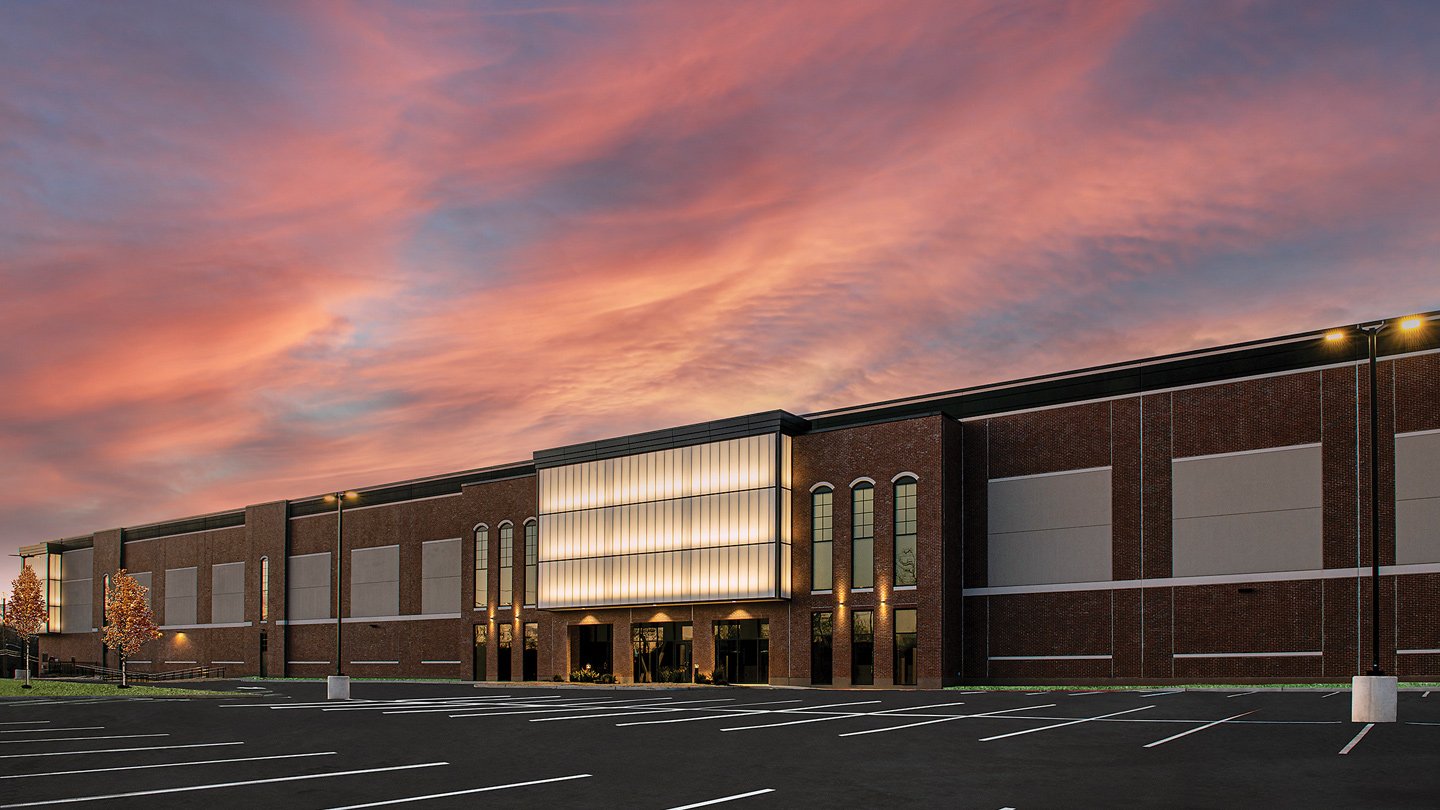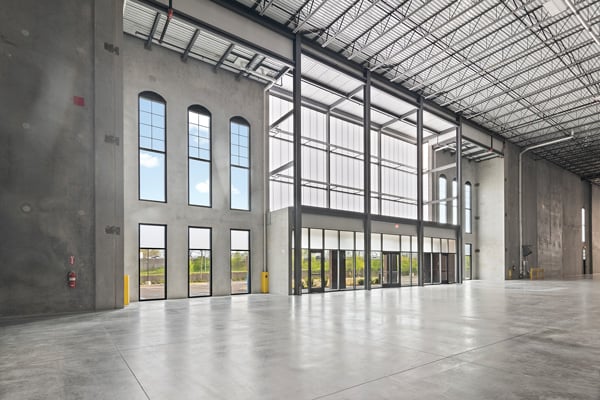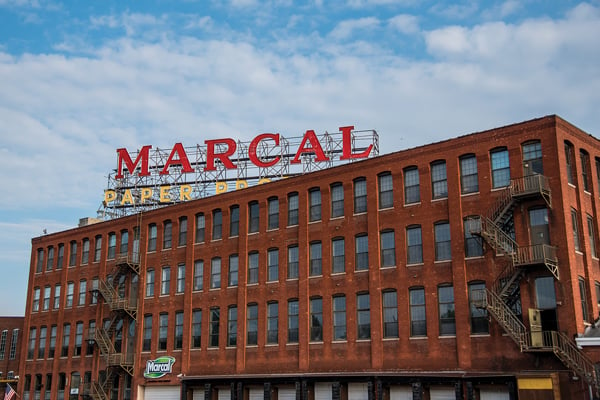
Trophy Industrial: A Call to Inspire Creativity, Legacy and Community
In New Jersey, a modern warehouse pays homage to the site’s history and surroundings.
“Trophy” is not a word typically associated with industrial buildings. Nor does it fit with the presumed aesthetic of a concrete box with some clerestory glass, a professional office facade in one or two corners, endless rows of loading docks, and fields of parking lots and truck courts. The standard design solution is to simply hide these buildings from view with heavy landscaping and berms.
However, when circumstances are right — which involves an alignment of market strength, site location, economics and community impact — there is a growing call for change. Within this shifting landscape, it is incumbent on developers to rethink the way industrial projects are designed and built.
Welcome to Elmwood Park
Crow Holdings Development knew it was buying something unique when it purchased a 12-acre site at 25 Market St. in Elmwood Park, New Jersey, in 2022. The property, visibly located alongside a busy stretch of Interstate 80 just 10 miles west of Manhattan, served as home to the Marcal Paper warehouse and its iconic neon sign for nine decades. A fire destroyed the structure in January 2019, taking a local landmark and hundreds of jobs with it.

The interior of the 207,000-square-foot 25 Market Street building, completed earlier this year. Matt McFarland, courtesy of Crow Holdings
At the time of the purchase, full site approvals were in place for a traditional industrial tilt-up building. The borough’s only extra requirement was installation of a marquee “Welcome to Elmwood Park” sign on one corner of the parcel. But Crow Holdings Development felt the property and its community deserved more and, partnering with M+H Architects and Alston Construction, set out to design a building that reflected the history of the site and respected the surrounding context.
Flash forward to completion of the 207,000-square-foot, single-story Class A commercial asset in early 2024. The enhanced architecture features an attractive brick exterior and arch-topped black windows inspired by the historic warehouses and manufacturing facilities built in and around nearby Paterson Great Falls, which was once a powerful economic engine. Among the building’s most distinctive features are large, translucent glass accent light boxes that marry classic elements with modern design and pay homage to the lost “Marcal” sign that was so well known to travelers along I-80.
The property’s transformation has introduced a commercial-use opportunity befitting its distinctive location and appealing to a range of potential users — even beyond traditional industrial. The outcome exceeded the borough of Elmwood Park’s expectations, and the response from residents and the regional real estate community has been rewarding.
“Crow Holdings Development has built a state-of-the-art building in Elmwood Park that looks more like a convention center than a warehouse,” said Mayor Robert Colletti. “Throughout the planning stages with the town, it became increasingly apparent that the owners were committed to beautifying the property. True to their word, the comprehensive plan that was agreed to by all parties came to fruition.”
Let Go of the Cookie Cutter
The trend toward smaller, infill redevelopment projects like 25 Market Street provides an opportunity to take a step back, embrace a site’s distinctive context and add a generous dose of creativity.
“Unlike huge speculative facilities constructed in fields along highways, there is nothing cookie-cutter about designing this type of industrial building,” said Larry Valenza, principal of M+H Architects. “It’s easy to just repeat what we’ve done in the past. But when a client gives you free rein to come up with ideas that are not the same old, same old, everyone gets excited.”
The call for originality can positively inform and improve the design. “Projects with a history are the most fun, and the story behind this site is compelling,” Valenza said. “The original warehouse’s place and time established a vision and gave us a chance to incorporate familiar materials like brick, steel and glass in new ways. We designed a building that still functions as a modern warehouse but looks completely different.”
“We want to do projects that are aspirational, but the worst thing is putting in the effort and having no one notice,” he continued. “The response to this outcome has been truly rewarding.”
Justify Better-looking Buildings
Considering today’s land values and market rents, Crow Holdings Development believes industrial tenants, their employees and communities deserve better-looking buildings — with the same type of extra touches that add value in other real estate asset classes.

The property previously served as home to the Marcal Paper warehouse and its iconic neon sign. Courtesy of Crow Holdings
For 25 Market Street, the cost of the brick cladding, translucent glass light boxes and other enhancements added about $1 million ($5 per square foot) to the project cost. While this number is not insignificant, it can be reasoned that in New Jersey and other major industrial hubs, higher rents mean that developers can afford to spend more. However, feasibility remains an important factor; it is a matter of what makes sense for a specific market and site. The logic is clear that high-end retail on Rodeo Drive looks different than a suburban strip shopping center. Industrial design has rarely been considered in this way, but perhaps it is time that it should be.
“Trophy industrial buildings like 25 Market Street bring users a much-needed elevated product,” said Rob Kossar, vice chairman of JLL. “Over past market cycles, the vast majority of buildings were built with nearly all the same facade and frontage features, which some consider drab and undifferentiated. Trophy buildings allow users to elevate their brand and curb appeal to a much greater level than everyone else. Think corporate headquarters or locations where clients come visit.”
Kossar added that this visual enhancement goes hand in hand with tenants gaining an advantage when it comes to attracting and retaining talent, noting that labor remains a top driver for site selection. “And given the rapid rise in rents over the past five years, the additional cost/rent for a user to lease a trophy building is now fairly small on a percentage basis,” he said.
Embrace Change and Inspire
Looking beyond the concrete box is a surefire way to distinguish properties and their developers. But earning a reputation for building the best buildings requires a willingness to stretch capabilities. Developers can start by asking themselves, “What can we be doing differently?” While it must make economic sense, it is vitally important to strive toward disrupting the status quo rather than simply letting an underwriting model and standard assumptions drive a project.
Trophy assets have the potential to inspire: the designer’s creativity, the tenant’s legacy and the community’s pride. The realization of that potential begins with the real estate community challenging itself to approach the next generation of infill redevelopment with a new set of standards founded in quality and focused on the future.
Clark Machemer is senior managing director at Crow Holdings Development.
Entitlements and Industrial’s Image IssueThe challenges of securing entitlements and countering NIMBY sentiment are well documented nationwide. Could trophy properties help build support and credibility for the industrial development community? Thomas Dalfo, senior vice president, real estate services for PIDC, Philadelphia’s public-private economic development corporation, has witnessed firsthand the difference in how projects are received. “As we create plans for sites, we engage with community organizations and policymakers to make sure that the developments are, if not necessarily loved, not aggressively opposed,” he said. Proposed developments that offer a benefit to the community are easier pills to swallow. “It’s important that the perimeter edge interface between nonindustrial and industrial be respectful, and design is an important piece of that,” Dalfo said. “Understanding the context for the site and the area around it, and responding with something suitable, is really just smart development, even if it requires flexibility and investment. Those who recognize that will get through the process with less opposition.” For anyone selling an unentitled property, consider this food for thought: A slightly lower land price enables the buyer to invest that cost savings in design enhancements that will help propel the project through approvals. And while selling a property that ultimately will bring top-dollar rents for less may seem counterintuitive, it may be more beneficial than sitting on a negative-income asset indefinitely. |




